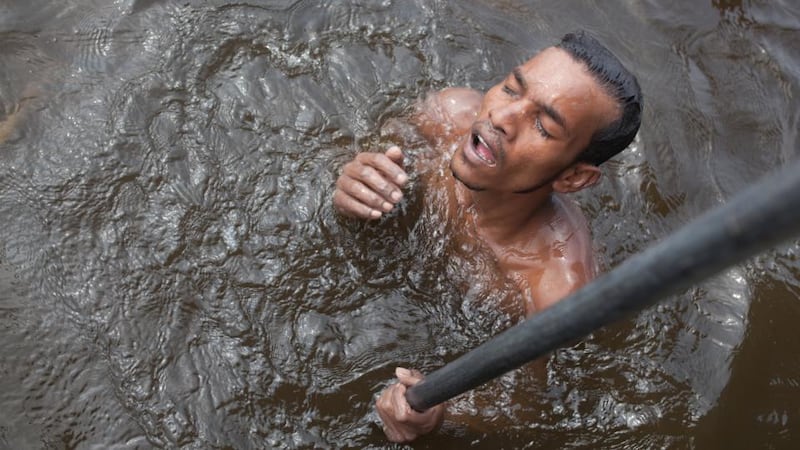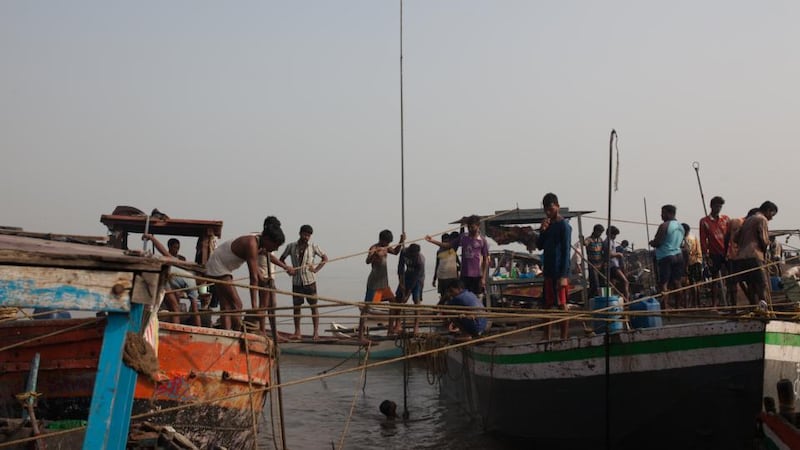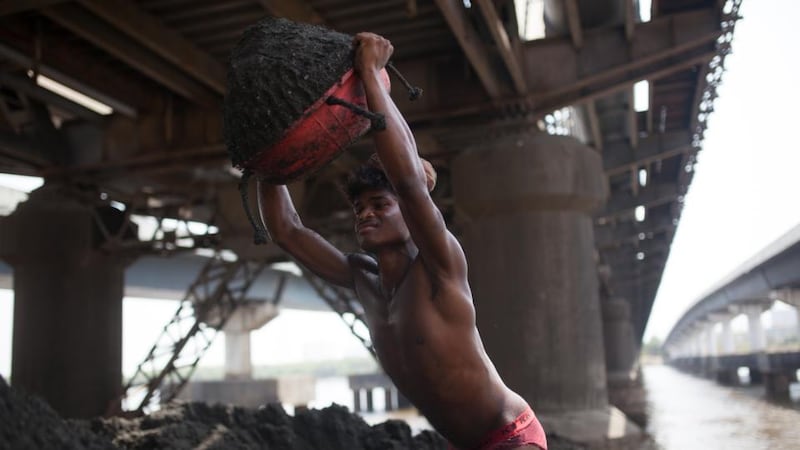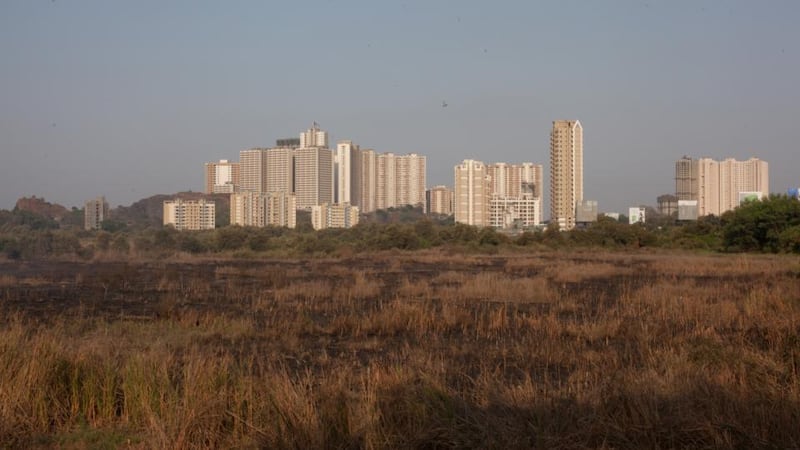At dawn on a sultry summer morning, Balaram Raute stood on a boat bobbing in a murky creek outside Mumbai, waiting for the sun to light up the water so he could dive in to dig sand.
Minutes later he was neck-deep in Vasai Creek where untreated chemicals and industrial waste float – and, at times, the corpses of fellow workers.
While Indian authorities and mining officials deny the existence or the dangers of an illegal sand mining industry, an investigation found miners are dying to meet rising demand from a booming construction sector.
Although there is no official data, studies estimate illegal extraction of sand in India generates about $150 million (€127 million) a year, with the states of Gujarat and Maharashtra the main hotspots.
An investigation in Mumbai, the nearby city of Thane, and villages in the neighbouring district of Palghar over two months found evidence of at least two deaths in the past year and more in the past few years – none of which were reported.
“I don’t feel scared,” said Raute (27), wiping the water from his eyes. “My only worry under water is to find good sand.”
Raute is among about 75,000 men, many from India’s poorest areas, who work illegally as sand miners along Vasai Creek, diving 12 metres into pitchblack waters clutching just a metal rod for balance and an iron bucket to fill with sand.
Although manually mined creek sand by cheap labourers plays second fiddle to the large quantities of sand extracted legally by suction pumps from rivers, it is in high demand in a nation of 1.3 billion people with fast growing cities.
The sand is used across the construction industry, in the flooring of upmarket apartments in Mumbai and Thane and to plaster the walls of cheap, illegal homes in distant suburbs where people are moving as space tightens in the cities.
Sand mining has been declared illegal in most parts of India with countless court petitions highlighting the danger it poses to coastlines, marine life, and sand reserves.
Uneven depths in creeks and rivers caused by illegal sand mining can spark currents and whirlpools, posing a danger not just to miners but anyone using the rivers, with multiple drownings across India blamed on the black market for sand.
‘India’s gold’
The crackdown has helped make sand so valuable it has been dubbed “India’s gold”, with mining dominated by criminal gangs.

The so-called “sand mafia” is a network of businessmen, transporters and also criminals who often enjoy political patronage and are unafraid to use violence.
Despite the danger involved, divers keep on working, making 1,000 Indian rupees (€13) for a boat-full of sand and gravel, much higher than the average daily wage in India of about 270 rupees. Their employers sell the sand for up to 5,000 rupees to be sieved, washed, and bagged for building projects.
But the potential rewards and depleting reserves have intensified the risks, with frequent reports of opponents attacked and even murdered. Officials and bureaucrats have been arrested over the past year and corruption is rife.
In June alone, a police inspector in the central Indian state of Madhya Pradesh was seriously injured and another policeman crushed to death in the northwestern state of Rajasthan for taking on the sand mafia – the latest in a string of attacks.
A district head in the southern state of Karnataka was attacked in a raid on an illegal sand mining site in April – the same month in which a policeman in the northern state of Uttar Pradesh was run down by a sand truck he tried to stop.
Employers who identify themselves as Mumbai’s native fishermen want the state government to legalise manual mining, arguing it does not harm the environment like suction pumps.
Critics, however, say the real reason for seeking a legal stamp is to insulate them from hefty fines levied each time officials seize trucks filled with illegally mined sand.
But there is virtually no discussion about the threat to human lives among the authorities or builders, although miners speak of death as a common occurrence.

“I have seen people fall and drown. There is no count of the number of people who have died here,” said Radheshyam Sahni, who has been mining sand from the creek bed for 15 years and said he has seen at least five deaths himself.
Denials and corruption
Local police denied miners were dying in the creeks.
“We have registered cases of theft of sand and also violations of environmental norms but there are no cases ever of drowning,” said S D Jadhav, a senior police inspector with the local police station, when asked about the deaths.
Sandeep Khakha, a migrant worker from Chattisgarh who works on one of nine sand ports on a 16km stretch of the Vasai Creek, said he saw two divers lose their lives last year.
For the creek bed is not smooth but has sand dunes measuring 1.5 to 2 metres in height and scooping out sand loosens these structures. The work can be fatal if a sand dune falls on a miner, burying him if he fails to right his balance.
“I never lose my grip on the metal rod. If I lose my balance, I am gone,” said Khakha.
“It is pitch dark under the water. I just feel a wall of sand. I have to dig my feet in it, balance myself and push the bucket into it to fill it.”
Other workers at Vasai Creek said deaths go unreported, with hundreds of boats in the creek nightly, and they only find out when the body of a drowned diver floats to the surface a day or two after disappearing or they find it buried on the creek bed.
"There have been so many times when I have gone down for sand and touched a body," said Shiva Shahni (35), a worker at a sand port in Bhiwandi, Thane, who migrated from the northern state of Uttar Pradesh.
Shankar Meghwali’s son Mahesh is one of the miners who died.
Outside the family’s mud house in Mohokhurde village in Vikramgad – a little over 100km from Mumbai – is a holy basil plant where Meghwali and his wife buried the ashes of their son who drowned in Vasai Creek five years ago.
He was 22, just married and with a baby girl.
“He went down once and came up. The second time he went inside the water, he didn’t come up,” Sanguna, Mahesh’s grandmother, said.
Mahesh’s body was found floating in the water a day later.
“My son would accompany me to the creek as a child and by the time he was 15 he joined the work himself,” Meghwali said.
Grim reminder
The father-son duo worked 20 days a month, bringing back earnings that helped them build a house that they painted blue and emblazoned with a boat to indicate their profession.
The sculpted boat is now a grim reminder of their lost son.
“I don’t go sand mining anymore. My son lost his life working there. I feel uneasy going to the creek,” Meghwali said.
About a dozen people from Meghwali’s village worked as sand miners, but the numbers fell after his son died.
Activists opposed to sand mining have been shocked by the deaths and suffering accompanying the surge in demand for sand.
"I could never have imagined all these new buildings and beautiful constructions you see in Mumbai would have this terrible back history of human suffering," said Sumaira Abdulali, a leading voice against sand mining in India and founder of the environmental advocacy group Awaaz Foundation.
“Even if people see [the creek], they would think these are fishing boats and not imagine that people are dying, suffering to produce construction [material],” said Abdulali, who has been attacked twice by the sand mafia for opposing mining.

Campaigners fear the number of deaths will only get worse with the construction boom set to continue and demand for sand forecast to double by 2020 as the government pursues a “housing for all” programme.
They want workers to be given alternative and legal ways to make a living which will mean they have social security cover and compensation in the event of an accident or death.
"Cities will need a lot more houses for which more sand is required," said Ashutosh Limaye, head of research at global real estate services and consultancy firm Jones Lang LaSalle.
For the miners, the soaring demand means a 12-hour work cycle that starts with setting sail into the creek at midnight to find a good spot to dive.
The dives are getting deeper as more sand is removed.
At dawn, the divers begin, descending to the creek bed up to 200 times over the next six hours, coming up for air after every 30 to 40 second dive.
None of the workers are given any safety equipment.
However India's national association of real estate developers, Confederation of Real Estate Developers' Associations of India (CREDAI), denied manual mining takes place and a local sand mining association dismissed any risks.
“This work has been going on for over 150 years. This is traditional work and is good physical exercise for those who do it,” said Bhagirath Ramchandra Mhatre, who heads the Bhiwandi Taluka Reti Utpadak Sanghatna, an association of sand businessmen in Thane.
“There are no grievances, no pain in this work . . . They are like fish under water,” he said, adding workers were reluctant to wear gloves or masks as they find it uncomfortable.
Reluctant
Amar, who gives only his first name, wears a thick, gold chain around his neck and is nattily dressed in a red T-shirt and jeans as he watches workers empty the sand they have mined and collected on their boats all day from Vasai Creek in Thane.
He is one of the many employers of sand miners and visits the banks of the creek most evenings to take stock of the work, but he is now worried.
Miners can only go down into the creek during a low tide so get a four-day break every 10 days during which they return home.
“The workers are going home for four days but I will send my person with money to their villages on Sunday to get them back,” said Amar.
“We give them 500 to 1,000 rupees to take care of their travel expenses. This is the only way they will come.”
With this kind of money, workers continue to return to the creeks, despite complaining of bleeding ears and headaches, and employers just increase wages if health fears start to impact the number of willing miners.
The workers maintain that no force is ever used to get them to the creek and payments are always made on time.
"There is no work, no money in the village. What will you do here?" said Lakshman Bhau Khotade, painting a temple in Dharampur village in Palghar.
“I make 100 rupees a day for painting but I earn a 1,000 rupees a day for mining sand,” said Khotade who has suffered hearing problems for nine years.
Dig deeper
The sand miners on Vasai Creek dread coming back with an empty boat and no wages – an increasingly common occurrence as sand reserves diminish.
Sand scarcity has set off alarms with the Indian government issuing guidelines last year on sustainable mining and the United Nations flagging concerns about sand consumption globally being much higher than its renewal in a 2014 report.

Officials from the ministries of environment and mining said the onus of regulation is on each of India’s 29 states.
District officials in Thane said they had cracked down on illegal sand mining, seizing more than 200 trucks between April and May and collecting 360,000 rupees in fines.
But the deaths of miners find no mention in the crackdown.
Satish Magar, national president-elect of CREDAI, was confident that his organisation had never come across the practice of manual mining.
“People going down with a bucket to get sand is unheard of. This issue has not surfaced at all,” he said.
“We are not involved in doing anything that is inhuman and we will take it up [if we find such instances].”
However another CREDAI official acknowledged lives were at risk but put a distance between illegal mining and the real estate industry.
“At the individual level, we are aware that lives are put at risk in mining of sand in several ways,” said Jaxay Shah, president of CREDAI in an e-mailed response.
“However, CREDAI is an association of real estate developers and as such has no direct involvement in sand mining. Real estate and CREDAI have no intimate connection to sand mining to take up concerns of manual miners.”
The employers argue they were miners themselves until about the late 1990s, when they had made enough money from sand and could employ people to do the work.
They started bringing workers, often children, from tribal villages outside of Mumbai and from other states, many of whom had never seen a large body of water, let alone worked in it.
Raute was among those brought in for this work about 10 years ago. He was 16 when a relative took him and 12 others from their village in Palghar – about 100km from Mumbai – with the promise of a well paid job.
He said initially the work was difficult but once he understood how it was done, he could do it.
“My children will go to school and it will be better if they find good work. They should not go through this,” said Raute.
Thomson Reuters Foundation










